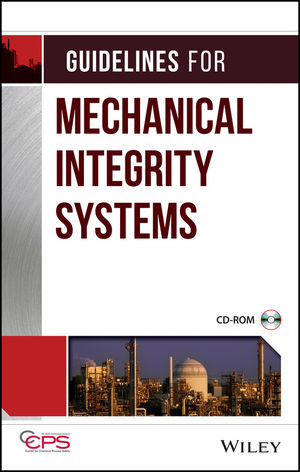Guidelines for Mechanical Integrity SystemsISBN: 978-0-8169-0952-0
Hardcover
320 pages
August 2006
 This is a Print-on-Demand title. It will be printed specifically to fill your order. Please allow an additional 15-20 days delivery time. The book is not returnable.
|
||||||
List of Tables xiii
List of Figures xv
Items on the CD Accompanying This Book xvii
Acronyms and abbreviations xxi
Glossary xxv
Acknowledgments xxix
Preface xxxi
Management Overview of the Guidelines xxxiii
1 INTRODUCTION 1
1.1 What is Mechanical Integrity? 2
1.2 Relationship to Other Programs 3
1.3 Expectations for the Ml Program 3
1.4 The Effect of RAGAGEPs 5
1.5 Structure of this Guidelines Book 6
1.6 References 8
2 MANAGEMENT RESPONSIBILITY 9
2.1 Facility Leadership’s Roles and Responsibilities 9
2.1.1 Organizational Roles and Responsibilities 10
2.1.2 Roles and Responsibilities Matrix 10
2.1.3 Reporting Mechanisms 11
2.1.4 Auditing 14
2.2 Technical Assurance Responsibilities 14
2.2.1 Defining Acceptance Criteria 14
2.2.2 Providing Technical Content 15
2.2.3 Establishing Metrics 15
2.2.4 Ensuring Technical Review 16
3 EQUIPMENT SELECTION 17
3.1 Reviewing Program Objectives 17
3.2 Establishing Equipment Selection Criteria 18
3.3 Defining Level of Detail 21
3.4 Documenting the Equipment Selection 22
3.5 Equipment Selection Roles and Responsibilities 23
Apendix 3A, Sample Guidelines for Selecting Equipment for the MI Program 25
4 INSPECTION, TESTING, AND PREVENTIVE MAINTENANCE 29
4.1 ITPM Task Planning 30
4.1.1 ITPM Task Selection 30
4.1.2 Developing Sampling Criteria 42
4.1.3 Other ITPM Task Planning Considerations 44
4.1.4 ITPM Task Scheduling 45
4.2 Task Execution and Monitoring 46
4.2.1 Defining Acceptance Criteria 46
4.2.2 Equipment and ITPM Task Results Documentation 47
4.2.3 ITPM Task Implementation and Execution 49
4.2.4 ITPM Task Results Management 49
4.2.5 Task Schedule Management 51
4.2.6 ITPM Program Monitoring 52
4.3 ITPM Program Roles and Responsibilities 53
4.4 References 53
Appendix 4A. Common Predictive Maintenance and Nondestructive Testing Techniqes 58
Appendix 5 A. Sample Training Survey
5 Ml TRAINING PROGRAM
5.1 Skills/Knowledge Assessment 61
5.2 Training For New and Current Workers 64
5.3 Verification and Documentation of Training Effectiveness 64
5.4 Certification 66
5.5 Ongoing and Refresher Training 69
5.6 Training for Technical Personnel 69
5.7 Contractor Issues 71
5.8 Roles and Responsibilities
5.9 References
6 Ml PROGRAM PROCEDURES 77
6.1 Types of Procedures Supporting the Ml Program 79
6.2 Identification of MI Procedure Needs 81
6.3 Procedure Development Process 83
6.4 MI Procedure Format and Content 87
6.5 Other Sources of MI Procedures 90
6.6 Implementing and Maintaining MI Procedures91
6.7 Procedure Program Roles and Responsibilities 92
6.8 References 92
7 QUALITY ASSURANCE 95
7.1 Design 96
7.2 Procurement 97
7.3 Fabrication 98
7.4 Receiving 99
7.5 Storage and Retrieval 99
7.6 Construction and Installation 100
7.7 In-service Repairs, Alterations, and Rerating 101
7.8 Temporary Installations and Temporary Repairs 102
7.9 Decommissioning/Reusc 103
7.10 Used Equipment 103
7.11 Spare Parts 104
7.12 Contractor-Supplied Equipment and Materials 104
7.13 QA Program Roles and Responsibilities 104
7.14 References 104
Appendix 7A. Design Review Suggestions 107
Appendix 7B. Sample Vendor QA Plan 110
Appendix 7C. Positive Material Identification 112
Appendix 7D. Sample Service QA Plan 116
Appendix 8A. Fitness for Service (FS) 131
8 EQUIPMENT DEFICIENCY MANAGEMENT 119
8.1 Equipment Deficiency Management Process 119
8.2 Acceptance Criteria 120
8.3 Equipment Deficiency Identification 122
8.4 Responding to Equipment Deficiencies 123
8.5 Equipment Deficiency Communication 127
8.6 Permanent Correction of Equipment Deficiencies 127
8.7 Deficiency Management Roles and Responsibilities 128
8.8 Reference 128
9 EQUIPMENT-SPECIFIC INTEGRITY MANAGEMENT 135
9.1 Fixed Equipment 137
9.2 Relief and Vent Systems 142
9.3 Instrumentation and Controls 144
9.4 Rotating Equipment 145
9.5 Fired Equipment 151
9.6 Electrical Systems 151
9.7 Fire Protection Systems 153
9.8 Miscellaneous Equipment 154
9.8.1 Ventilation and Purge Systems 154
9.8.2 Protective Systems 155
9.8.3 Solids-handling Systems 156
9.8.4 Safety-critical Utilities 157
9.8.5 Other Safety Equipment 157
9.9 Equipment-specific MI Activity Matrices 158
9.10 References 182
10 Ml PROGRAM IMPLEMENTATION 183
10.1 Budgeting and Resources 183
10.1.1 Program Development Resources 183
10.1.2 Initial Implementation Resources 187
10.1.3 Ongoing Efforts 193
10.2 Use of Software in Ml Programs 196
10.2.1 Use of CMMS 197
10.2.2 Other Software Used in MI Programs 198
10.3 Return on Investment (ROI) 200
10.3.1 Improved Equipment Reliability 200
10.3.2 Cost Avoidance 201
10.3.3 Regulatory Compliance and Industry Association Commitments 202
10.3.4 Reduced Liability and Reduced Damage to Corporate Reputation 202
10.4 References 202
11 RISK MANAGMENT TOOLS 203
11.1 Introduction to Common Risk-based Analytical Techniques Used in MI Programs 205
11.2 Incorporating Risk into MI Decisions 210
11.3 FMEA/FMECA 212
11.4 RCM 213
11.5 Risk-based Inspection 218
11.5.1 Equipment and Process Data 221
11.5.2 Risk Modeling 221
11.5.3 Inspection Planning Strategies/Guidelines 222
11.5.4 Other RBI Program Issues 223
11.6 Protection Layer Analysis Techniques 225
11.7 References 229
12 CONTINUOUS IMPROVEMENT OF Ml PROGRAMS 231
12.2 Program Audits 233
12.3 Performance Measurement and Monitoring 238
12.4 Equipment Failure and Root Cause Analyses 240
12.4.1 Failure Analysis 243
12.4.2 Root Cause Analysis 245
12.5 References 248
Index 249



